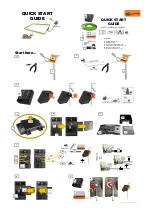
Shielded twisted pair cable is recommended for CAN bus wiring, with two conductor pairs
– one pair for CAN signals, and one pair for bus power. (During operation, the traction circuit in
electric vehicles can emit fairly high levels of electromagnetic interference, which can induce
noise on signal wiring.) This type of wire is a little uncommon, but you can either purchase it
from us or we can recommend vendors who may carry it in your part of the world.
Note that the cell sampling electronics is galvanically isolated from the CAN bus electronics
in order to maintain isolation between your traction circuit and vehicle chassis. There should
also be no external electrical connections between HV wiring and CAN bus wiring. Ensure
all wiring is secured so it will not become damaged from vibration or abrasion.
For optimum performance, CAN buses should be wired as a single daisy chain of devices
(without branching), and need to be terminated at both ends of the bus with a 120Ω resistor
across the CAN H and CAN L lines. Modules and the MCU may be in any order on the
CAN bus, and the MCU does not have to be an endpoint (it could be in the middle of the
bus). Usually the CAN bus route requiring the shortest cable lengths is best. The diagram
below shows an typical topology for an example 24-cell battery pack.
ZEVA BMS12 v1.6 (c) 2014
ZEVA BMS12 v1.6 (c) 2014
–
–
+
+
B+
120Ω
B–
To MCU
example wiring for a 24-cell battery pack
Each BMS module needs to be assigned a unique ID on the CAN bus. This is done by adjusting
the small 16-position rotary switch near the top left of the board. Switch markings are in
hexadecimal, so “A” means ID 10, “B” means ID 11, etc. Your master control unit (such as
an EVMS) will need to be programmed accordingly with information about module IDs and
numbers of cells connected.
Note: Be sure to disconnect the BMS module’s cell connector before doing any battery pack
maintenance, to avoid subjecting the module to any unexpected voltages/spikes.
oPeration
PoWering uP
The BMS12 modules run most of their circuitry from CAN bus power. When the module
powers up, the onboard LED should light up green. The LED may display a variety of codes
as follows:
Green
BMS active, no errors
Blinking green
No CAN bus communications detected (or Idle mode)
Blinking red
No cells detected
Flashing green/orange
One or more shunt balancers active
Red
One or more cells over- or under-voltage
The BMS12 modules are unable to take any action if a monitored cell is out of safe voltage
range, and must communicate with an appropriate BMS master control unit which is able to
respond to any reported error conditions. Please refer to the user manual for your BMS master
control unit for advice on integration with BMS12 modules.
Your complete BMS should be “failsafe”, so if any BMS12 modules are not detected by the
MCU on startup, or if any cells are out of safe voltage range, the vehicle should not be able to
drive or be charged. It is a good idea to verify the failsafe by temporarily unplugging the cell
connector or unplug the CAN bus, and verify that this causes the MCU to stop the charger or
shut down the drive system.
VoLtage threShoLdS
BMS12 modules will come from the factory pre-programmed with voltage thresholds
according to customer request/requirements (LiFePO4 by default), but the thresholds can
also be reprogrammed anytime over CAN bus with an appropriate BMS master controller, or
a ZEVA EVMS Monitor. The following table lists recommended voltage thresholds for Lithium
Iron Phosphate (LiFePO4), Lithium Cobalt (LiCo) and Lithium Manganese (LiMn) cells.
chemistry
nom Voltage Min Voltage Max Voltage charge / Shunt
temp range
LiFePO4
3.2V
2.5V
3.8V
3.65V
-20˚C – 60˚C
LiCo
3.7V
3.0V
4.2V
4.0V
-20˚C – 60˚C
LiMn
3.7V
3.0V
4.2V
4.0V
-20˚C – 40˚C
LiCo cells have the highest energy density but also the highest volatility and are often run
very close to their safety limits. Cell manufacturers typically recommend charging to 4.2V,
while cells can suffer damage above 4.3V. As such we recommend a slightly lower charge
voltage until you are confident that your pack is balanced to very close tolerances before
5
4






















